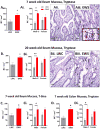Early weaning stress induces chronic functional diarrhea, intestinal barrier defects, and increased mast cell activity in a porcine model of early life adversity
- PMID: 28573751
- PMCID: PMC5650513
- DOI: 10.1111/nmo.13118
Early weaning stress induces chronic functional diarrhea, intestinal barrier defects, and increased mast cell activity in a porcine model of early life adversity
Abstract
Background: Early life adversity (ELA) is a risk factor for development of gastrointestinal disorders later in life. The underlying mechanisms through which ELA and sex interact to influence disease susceptibility remains poorly understood.
Methods: Utilizing a porcine early weaning stress (EWS) model to mimic ELA, we investigated the long-term effects of EWS on functional diarrhea, ileal permeability, mast cell activity and mast cell relationship with enteric ganglia.
Key results: Juvenile and adult EWS pigs exhibited chronic, functional diarrhea (EWS 43.6% vs late wean control(LWC) 4.8%, P<.0001), increased intestinal permeability (2 fold increase EWS vs LWC, P<.0001), and mast cell numbers (at 7 weeks and 20 weeks ~1.6 fold increase EWS vs LWC, P<.05). Compared with EWS male castrates (Male-C), females EWS pigs exhibited more frequent diarrhea (58.8% vs 29.9%, P=.0016), and increased intestinal permeability (1-2 fold higher in EWS females, P<.001). Increased mast cell numbers and their enhanced co-localization with neuronal ganglia were observed in both Male-C and female EWS pigs; however, female pigs exhibited greater release of mast cell tryptase upon activation with c48/80 (~1.5 fold increase, P<.05), compared with Male-C pigs.
Conclusions and inferences: These data demonstrate that pigs exposed to ELA exhibit increased vulnerability to functional diarrhea, intestinal permeability and mast cell activity. Further, these studies also showed that EWS female and Male-C pigs exhibited dimorphic responses to EWS with female piglets exhibited greater susceptibility and severity of diarrhea, intestinal permeability and mast cell tryptase release. Together, these findings mimic some of the key pathophysiologic findings in human functional GI disorders functional gastrointestinal disorders (FGIDs) suggesting that the EWS porcine model could be a valuable preclinical translational model for FGID research associated with ELA.
Keywords: developmental origins of health and disease; early life adversity; intestinal permeability; large animal model; mast cell; mast cell plexitis; translational research.
© 2017 John Wiley & Sons Ltd.
Conflict of interest statement
Competing Interests: All authors have read the journal’s authorship agreement and policy on disclosure of potential conflicts of interest. The authors have no competing interests
Figures





References
-
- Drossman DA, Li Z, Andruzzi E, et al. U.S. householder survey of functional gastrointestinal disorders. Prevalence, sociodemography, and health impact. Dig Dis Sci. 1993;38:1569–1580. - PubMed
-
- Chang L, Toner BB, Fukudo S, et al. Gender, age, society, culture, and the patient’s perspective in the functional gastrointestinal disorders. Gastroenterology. 2006;130:1435–1446. - PubMed
MeSH terms
Substances
Grants and funding
LinkOut - more resources
Full Text Sources
Other Literature Sources
Medical

